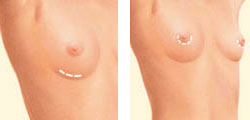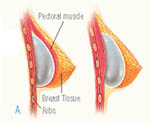Common Breast Augmentation Misconceptions
 Breast enlargement surgery can help women who are dissatisfied with their breast size, whose breasts have lost volume after weight loss or pregnancy, or who suffer from breast asymmetry. While there are rare chances of complications with any surgery, there are many breast augmentation myths floating around the internet and outside of plastic surgery offices. Below are a few that I would like to clear up.
Breast enlargement surgery can help women who are dissatisfied with their breast size, whose breasts have lost volume after weight loss or pregnancy, or who suffer from breast asymmetry. While there are rare chances of complications with any surgery, there are many breast augmentation myths floating around the internet and outside of plastic surgery offices. Below are a few that I would like to clear up.
Myth 1: You cannot breastfeed with implants. While it’s true that breast implants can cause issues with breastfeeding, this situation is rare. The placement of the breast implant and the type of incision used can have an impact on a woman’s ability to breastfeed after pregnancy; however, most women are able to breastfeed normally and naturally even with breast implants.
An incision along the crease of the breast as opposed to a nipple (areola) breast incision is more likely to allow a woman to breastfeed after pregnancy. Likewise, if the implant is placed under the pectoral (chest) muscle, the tissue involved with breastfeeding is less likely to be impeded by the implant. Make sure to discuss your family plans with your board certified plastic surgeon before surgery to help determine which type of breast augmentation surgery is best for you.
Myth 2: Silicone gel filled implants are dangerous. The FDA removed silicone implants from the market in 1992 because of a lack of information on long-term safety. However, after fourteen years of clinical studies, silicone implants were declared safe. In 2006, after much testing and review, silicone gel implants were approved for breast augmentation surgery by the FDA again.
 Regardless of the type of implant you receive, it’s important to follow up with your breast surgeon regularly and undergo annual mammograms with technicians who have experience screening women with breast implants.
Regardless of the type of implant you receive, it’s important to follow up with your breast surgeon regularly and undergo annual mammograms with technicians who have experience screening women with breast implants.
Myth 3: Everyone can tell when a woman’s had breast enhancement surgery. Breast sizes vary naturally. Even smaller framed women with a lower body-fat percentage can have large breasts without augmentation surgery. Some women pursue breast augmentation surgery looking for larger results, while others are more interested in a slight size enhancement. Breast implant sizing is an individual choice discussed between each patient and their surgeon.
When determining an appropriate breast implant size, I take into consideration the patient’s body type including her height, current breast size, the width of the shoulders, her weight, body shape, as well as desired breast shape and size. Most women want their breast augmentation results to look natural, though, with subtle enhancement that doesn’t give away that they’ve had surgery.
There are many more misconceptions about breast augmentation surgery and breast implants. Make sure to discuss all of your breast surgery questions or concerns with a board-certified plastic surgeon. For more information or to schedule your consultation, contact our office. You can stay up to date on the latest Atlanta plastic surgery news by connecting with me on Facebook and Twitter.
*Diagrams from ASPS
